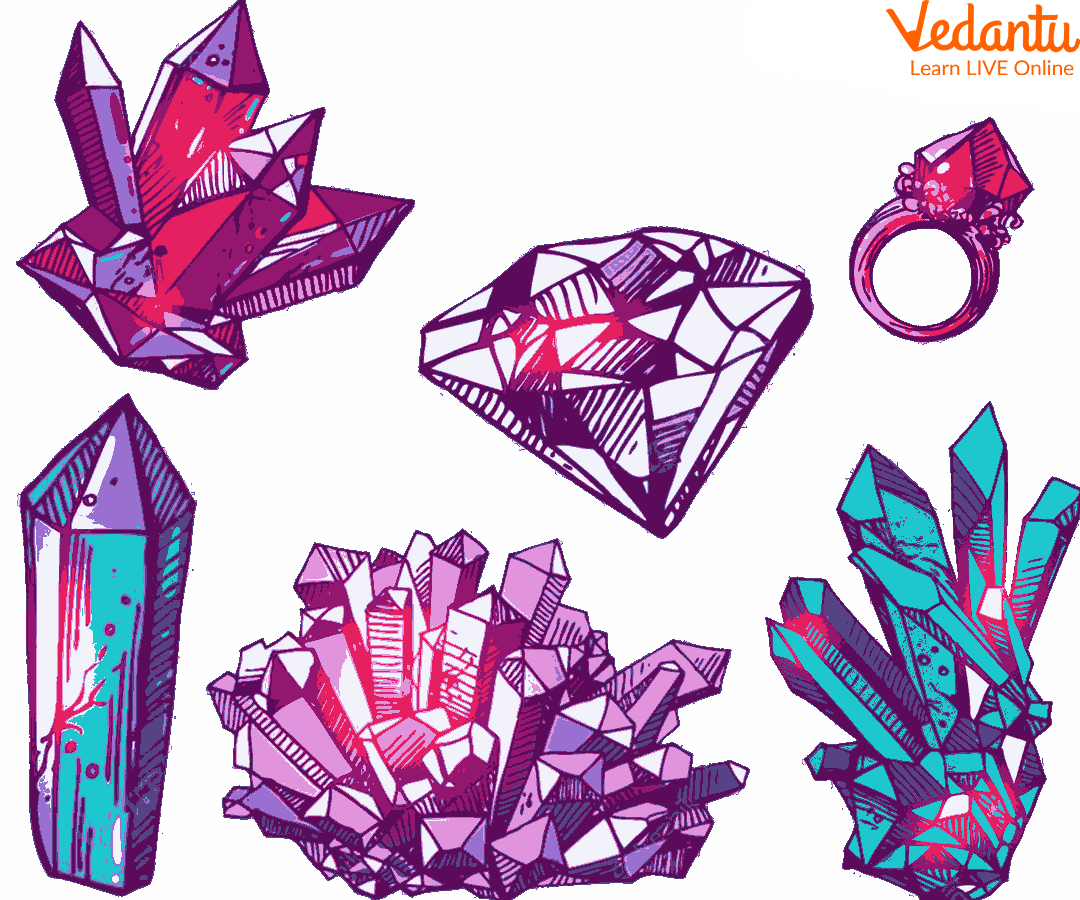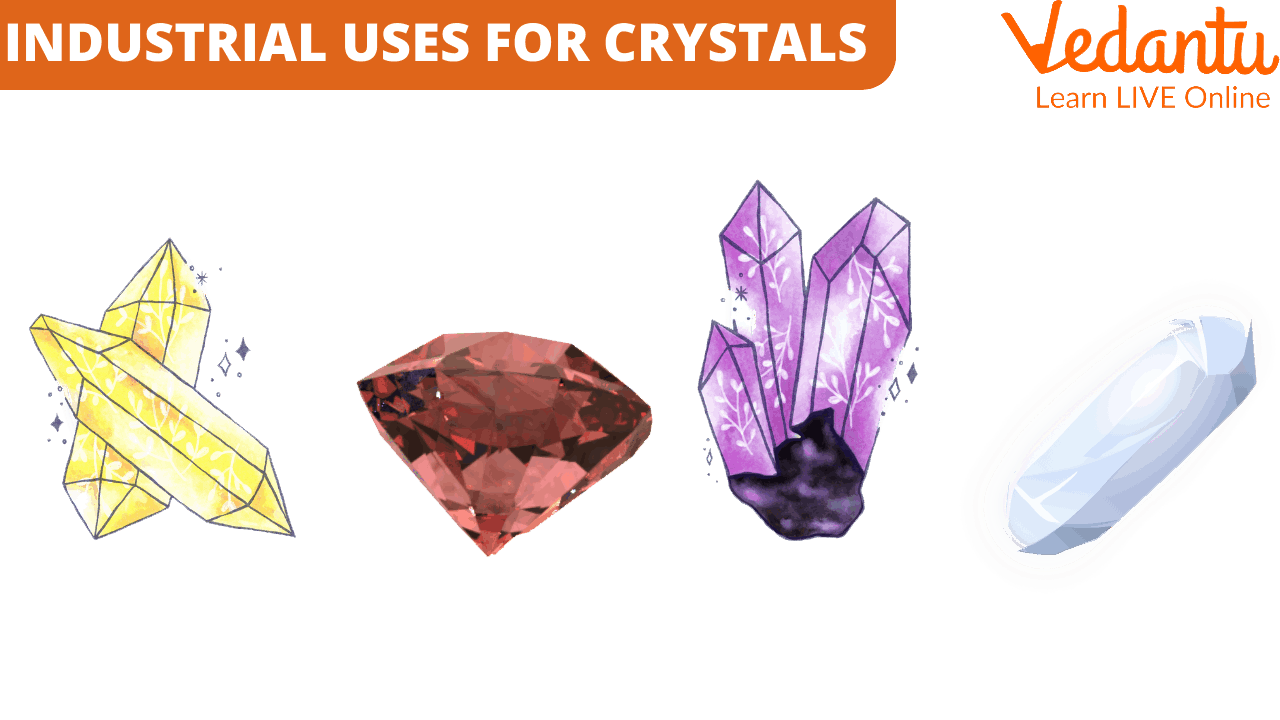




Introduction to Crystals
We usually think of coloured minerals when we hear "crystal." But there are other kinds of crystals too. Crystals are also found in graphite, table salt, and snow.
Crystals all have a molecular structure that is very well put together. A crystal's atoms are lined up in a grid pattern. Table salt crystals (NaCl) are made of cubes of sodium (Na) ions and chlorine ions. Each sodium ion has six chlorine ions.
What is the Shape of Crystals?

Crystals Defined
The shape of a crystal is made by how the atoms or molecules of a substance fit together. Crystals can form in a lot of different ways. But crystals made of the same material all have the same shape. For example, the molecules of salt come together to form a cube. So, salt crystals are square cubes. Sugar crystals look like columns with points at the ends. Quartz crystals are six-sided columns. Not everything that is not made of crystals has the same shape. Glass breaks into many pieces of different sizes and shapes when it breaks.
What does Crystal Look Like?
People usually think of solids as hard and solid. But when you look closer, the definition becomes less clear. For example, a cube of butter kept in the fridge is complex and is a clear example of a solid. The same cube of butter gets very soft after a day on the kitchen counter, and it's not clear if the butter is still solid or not.
Many crystals are hard at low temperatures but soft at higher temperatures. When they are below their melting point, they are called solids. Solid is something that keeps its shape until one touches it. The important thing is how long the shape stays the same. A fluid with a lot of viscosity keeps its shape for an hour but not for a year. The shape of a solid must hold for longer than that.
Uses of Crystals in Everyday Life
People can use the crystals:
To meditate with crystals.
To decorate your room or office.
To make you feel happy
To use it as jewellery
Bring good luck by keeping it in your pocket.
Industrial Uses for Crystals

Use of Crystals in Industries
Early civilisations employed crystal sands to cut rock and stone, make jewellery and ornaments and engrave. Synthetic crystals were more robust, cheaper, and quicker to produce than natural crystals. Thus they rapidly found a market in many sectors:
Semiconductor Watches - Watchmakers employ quartz, ruby, and sapphire. Rolex watches have scratch-resistant sapphire glass. Synthetic ruby is used in the watch and mechanical bearings.
Cutting Diamonds and Dust - Diamond bits cut stone blocks and decorative stones in industrial saws and ropes. Oil well drills employ diamond-studded drill bits. Jewellers and lapidary artists utilise diamond saws, copper laps with diamond dust, and diamond cleaning powder for jade and sapphire.
Ruby-Laser - This 1960 red light beam has minimum divergence and is strong. CD players, long-distance phones, surveys, and microsurgery use it. The small ruby laser pointer helps college instructors in lectures. Lasers can cut steel and drill diamonds.
Uses of Crystals in Technology
Quartz crystals are used in sonar, ultrasound, radios, transistors, semiconductors, and digital timepieces.
They are used in electric guitars, microphones, and most digital electronics.
They're used in ovens, barbecues, heaters, and lighters.
Crystals: Some Interesting facts
Crystallography is the study of how crystals are made and how they grow.
Some crystals, like diamonds, are just one big molecule made up of many atoms of the same element.
Many computer screens use liquid crystals to show what's on the screen.
They are often used in jewellery because they can shine and come in various colours.
There are living things that can make crystals.
Conclusion
Most nonliving things are made of crystals. Things like sugar and salt are made of crystals. Gold, silver, copper, and iron are, too. Diamonds, emeralds, and other gems are also crystals. Some things look like they are made of crystals, but they are not. Glass is one of these things. Its molecules are put together in no way that makes sense.
FAQs on Uses of Crystals
1. What is a crystal's unit cell?
The unit cell is one of the essential ideas in crystal structures. The smallest volume unit lets the same cells be stacked on top of each other to fill all the space. The whole crystal lattice can be made by repeating the pattern of the unit cell over and over in every direction.
2. What makes crystal?
Crystallization is the process by which a crystal forms. When liquids cool and start to get hard, they often turn into crystals. As the molecules in the liquid try to become stable, the group. They do this in a traditional way that keeps happening repeatedly. This makes the crystal.
Magma, molten rock, can turn into crystals when it cools. When something cools down slowly, crystals may form. This is how many valuable crystals like diamonds, rubies, and emeralds form.
3. Is crystal a type of rock?
Minerals and sediments also make rocks. However, crystals and rocks are not the same things. Minerals are all crystals. But not all crystals are minerals.









